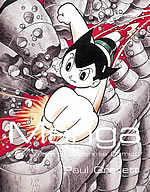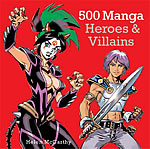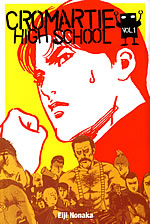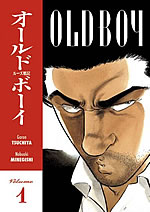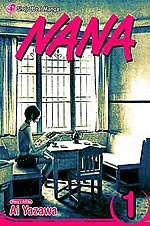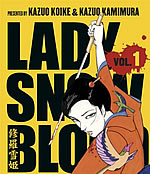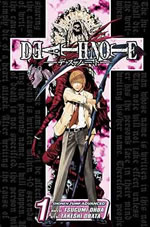Mangaphobia:
Manga For People Who Hate Manga
Are you mangaphobic? Maybe I can help. I fully sympathise with anyone who has been put off trying manga by their so-called ‘manga style’, the set of alien, alienating clichés of big Bambi eyes, teeny noses, cutesy smiles, mad haircuts, speed lines and sweatdrops. You can almost be forgiven for saying that all Japanese comics look the same, because a great deal of those put into English to date superficially do, since they have been cherry-picked to tap into the built-in niche following for their animated versions among ‘otaku’ SF/fantasy cartoon fans. Anime on TV, DVD and the cinema screen continues to be a highly effective ambassador for manga, but manga are so much more than anime. I wonder if it’s the welter of anime imports that may have distorted public perceptions and created the false impression that all manga conform to certain standardisations of subject and style found in fantasy anime. In fact, just as superhero comics don’t represent the entirety of American comics, so the preponderance of anime-related or anime-looking manga in the West represent merely one narrow band of the full spectrum of this massive mass medium. Don’t dismiss manga till you’ve tried to see the full spectrum.
Another deterrent for mangaphobes is the outlay for stories that can run to 12, 20 or more volumes. It still surprises me that most publishers don’t indicate anywhere how many there will be in a saga. Sometimes this is excusable, because the series is still running in Japan, so no one knows yet when it will end. But if it is already completed, I for one would like to know from the outset the total number of books I’m being expected to shell out to get the whole kaboodle (sometimes you can find out on the publisher’s sites). Luckily prices are getting better, now that Gollancz Manga have brought out their line of Viz titles at under a fiver and several bookstore chains are pushing 3-for-2 deals. Before you buy, other options are to check out the sneak peeks in free samplers or online or see what titles you can take out from your local library.
Another grumble from some is having to read manga ‘backwards’. More accurately, you have to read the pictures and balloon order right-to-left, but of course the dialogues inside the balloons read left-to-right, so you’re processing in two directions at once. True, it can be disorientating at first, but persevere and you’ll be surprised how you get used it. Remember, it’s also more respectful to the artists than having to flop their panels as if in a mirror just so we can read them more easily.
So if you’re wary of trying manga, but are open to suggestions, I’ll start by shamelessly plugging my own deliberately broad-ranging, eye-opening guide, Manga: Sixty Years of Japanese Comics. I heard that one Gosh! customer, a true manga aficionado, bought over £180 worth of books that he discovered through its pages. As for other reference works, don’t be too disheartened by the generic types - a buxom she-devil and a strapping swordsman - on the cover of 500 Manga Heroes & Villains (Collins & Brown). Inside, expert and champion Helen McCarthy casts her net far wider to encompass all manner of characters, from sports, history, business, girls romance, horror and others. To impose some order, she classifies them into eight A-to-Z lists of: male or female heroes; anti-heroes; male or female villains; teams; and two catch-alls, ‘non-humanoid & semi-human heroes and villains’, and ‘historical, mythical & literary heroes and villains’ from Nefertiti to Hitler. A minefield of information, this 352-page directory fortunately comes with an index, so if you don’t know the characters’ names, you can always find them by looking up their creators or the titles of their manga. Or just dive in and see where she takes you.
A sensitive interpreter of the culture, Helen packs her entries with facts, plot synopses and real insights to many series, several tantalisingly untranslated as yet (notably by Tezuka). By writing about various characters, good, bad and in-between, from the same story, she can reveal its themes from multiple perspectives. She adds some more in-depth spotlights on creators like Akira Toriyama, Go Nagai, Leiji Matsumoto, and megastars like Lupin III, Godzilla and Golgo 13. Not every entry can be illustrated, but with over 160 images, mainly covers, there’s much to look at too.
No short survey can be exhaustive; as she says, "half the challenge of doing a book like this is deciding what to leave out". What she has chosen to put in inevitably reflects Helen’s tastes, which generally veer towards manga linked with anime, her other passion. Now anime movies are capable to doing so much (look at Hayao Miyazaki), but still they tend to be dominated by versions of manga’s space operas and epic fantasies, because Japanese directors on a tight budget find such fare too expensive to film in live-action. For cheaper live productions, they turn to the wealth of manga’s other diverse and engaging genres.
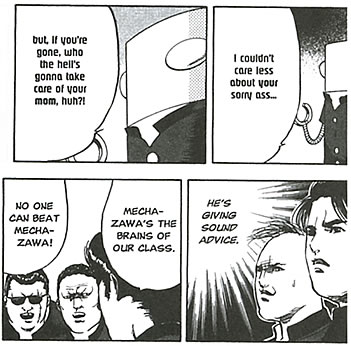
Evidence of these comes from a recent Japan Foundation manga-to-film season around the UK. Audiences could discover Cromartie High School (ADV Manga) based on Eiji Nonaka’s wacky Pythonesque skits about the pecking order and posturing of Tokyo’s dumbest punk pupils, among them a mute Freddie Mercury lookalike, a gorilla and a tin-can robot. If you never thought table tennis was your thing, the film Ping Pong will grip you with Taiyo Matsumoto’s tale of tabletop rivalries and speeding balls; now that the DVD is out, could Viz please get round to translating this sports gem? A recent classic in the shojo or girls’ genre is Kiriko Nananan’s single-volume Blue (Ponent Mon) about the deepening friendship between two schoolgirls, made into a movie in 2001.
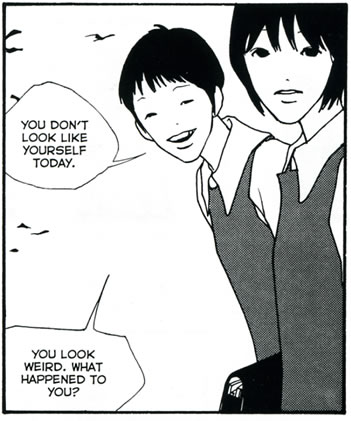
Manga’s freewheeling storyworlds are the key well-spring of some of the strongest hits on the big and small screens, from 2003’s Old Boy(Dark Horse) and last year’s Nana (VIZ), friendships and romances among touching twenty-somethings from the manga by Ai Yazawa. While the film of Dragon Head (Tokyopop) may not have topped the polls, the original 10-volume manga by Minetaro Mochizuki is a chilling post-earthquake shocker, highly recommended, as is Lady Snowblood (Dark Horse), the source of the movie that "inspired" Tarantino’s Kill Bill.
Two of my current favourite translations are also lined up for the cinema, but why wait when you can catch the compelling manga now? Naoki Urasawa’s Monster (VIZ) is an 18-volume rollercoaster ride, already adapted into an anime TV series. The prospects for Japanese super-surgeon Tenma at a renowned German hospital look promising, as long as he lets himself be exploited by the hospital’s callous director and by his fiancée, the director’s spoilt daughter Eva. Status, funding, publicity, are the director’s prime concerns, so when it comes to saving lives, a famous opera singer is much more important than some lowly Turkish labourer. As Eva tells him, "After all, people’s lives aren’t created equal."
Tenma won’t accept this ethical compromise. His career and life, however, unravel after he ignores an order to operate on the city’s mayor and decides to save a critically injured boy, whose twin sister is in shock and whose parents have been mysteriously killed. Tenma loses everything to save this one child’s life. His faith that he did the right thing begins to falter, as others around him inexplicably die. Some ten years later, he comes face-to-face with the angelic-looking killer and realises the horrors he is unwittingly responsible for. How far will Tenma go to stop this "monster" he saved from death? Drawing in a low-key, naturalistic style, Urasawa unfolds his drama with clinical precision and stokes the tension as Tenma becomes a prime suspect in the mounting multiple homicides.
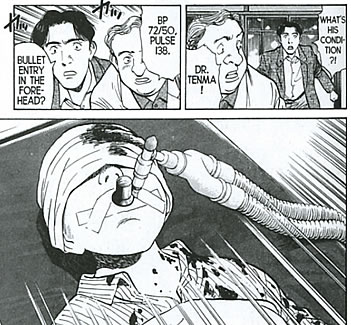
My other tip is Death Note (VIZ) about the lethal relationship between bored student genius Light and a bored death god called Ryuk, whose Death Note falls into his hands. What would you do if you found a notebook with instructions on how it can kill whatever human name is written inside it? Watching the TV news, Light decides to test it on a killer holding hostages in a school. When reporters announce that the criminal has died from a heart attack, Light is almost convinced it works, but decides to try it out on the street.
Here, Light’s superiority and self-righteousness surface as he ponders, "Start looking around you and all you see are people the world would be better off without." Spotting a biker harassing a girl and overhearing his name, he writes it into the Death Note book followed by the words "Traffic Accident". Before his eyes, almost instantly the biker is mowed down by a juggernaut truck. Light’s revulsion and guilt, however, soon give way to a mission to "clean up" the world. "I’ll make a world inhabited only by people I decide are good!" Complemented by Takeshi Obata’s beautifully crisp artwork, writer Tsugumi Ohba’s moral dilemmas are fiendishly clever, as cool-hearted know-it-all Light tries to evade Interpol’s tricky unseen super-agent, code-named ‘L’, in an escalating cat-and-mouse game with the lives of millions.
A prescription of class acts like these, rich in characterisation and plot, might just help you conquer your mangaphobia once and for all.
Posted: August 13, 2006The original version of this article appeared in Comics International, the UK’s leading magazine about comics, in 2006.













